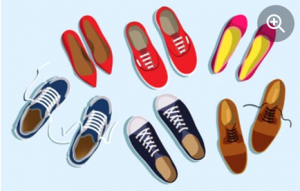
Reducing your footwear footprint
Keep durability, repairability, and recyclability in mind when choosing new shoes.
Reuse
In cases where shoes are clean and usable but simply the wrong size, fit, or function, consider donation or consignment. Keep it local by offering your clean, good condition shoes to friends, neighborhood listserves, online groups, and clothing swaps. With children, offer to take hand-me-downs from older kids and find familes to pass shoes down to.
Use Re:Source to view a list of charitable thrift stores that accept shoes in your area in addition to buyback opportunities. For shoe drives, wearable shoes are redistributed to areas of need through a partnership with Soles4Souls.
Specialty and sports shoes–cleats, rock climbing shoes, ski & snowboard boots–can be resold at sporting goods consignment shops and pre-owned sales. Dance shoes can be put to use by theatre companies like Joy in Motion.
Restoration
For more extensive repairs such as resoling or restitching - visit the Re:Source list of shoe repair shops in your area. A small investment can prolong the useful life of your footwear, reduce shoes headed to the landfill, and support a local business.
DIY
Many shoes can be restored at home with simple tools and materials. Some brands offer replacement of soles, straps or other repair for a fee, have repair shop partnerships to extend the life of your favorite shoe - like Chacos and Birkenstocks - or simply have care instructions. Shoes, sandals, and boots that are clean and functional but lacking in style can be dyed at home or by a professional. Laces can be changed. Uppers and straps can be altered for better fit.
Sneaker Care
- Basic 6-Step Shoe Cleaning
- Cleaning Suede Shoes
- How to get Your White Shoes Looking Brand New
- Removing Creases & Wrinkles
Additional Shoe Care Tips.
Recycle
Shoes do not belong in the curbside recycling bin. Few shoes are truly recycled–turned from an old product into a new product–due to the variability of materials and difficulty separating them from one another. Recycling is the final option when the footwear is not a candidate for repair or reuse (by you or someone else). Recycling options are limited and often require returning a shoe to its manufacturer.
Nike’s recycling program Reuse a Shoe hosts collection bins in Nike stores around the country. They accept any brand of athletic shoe (no spikes, sandals, or boots) and sort wearable from unwearable shoes. Unwearable shoes are broken down, the rubber is isolated and turned into Nike Grind material used in flooring and sport courts.
Teva’s recycling program TevaForever offers a pre-paid label for consumers to ship used Teva sandals back to the company for recycling into playground surfaces in partnership with TerraCyle.
With regular cleaning and occasional repair, you can extend the life of your footwear and keep it out of the landfill.

